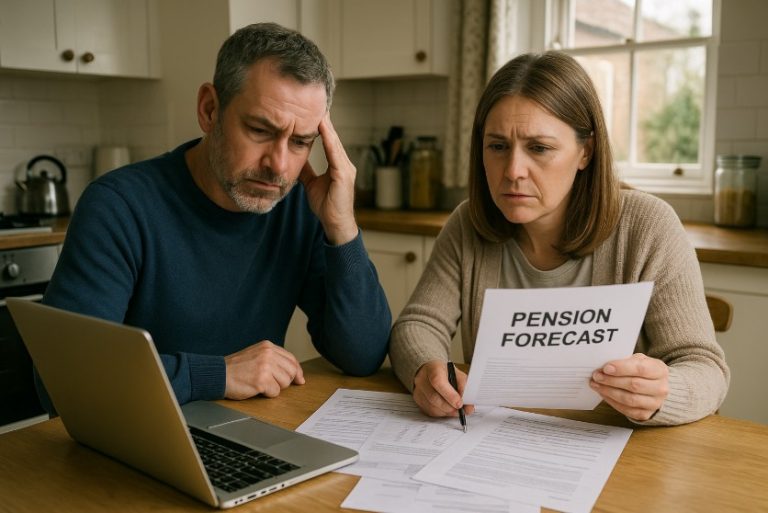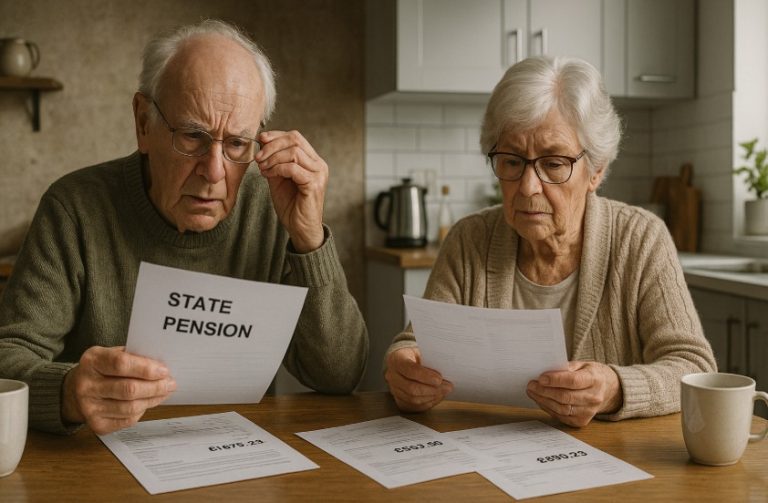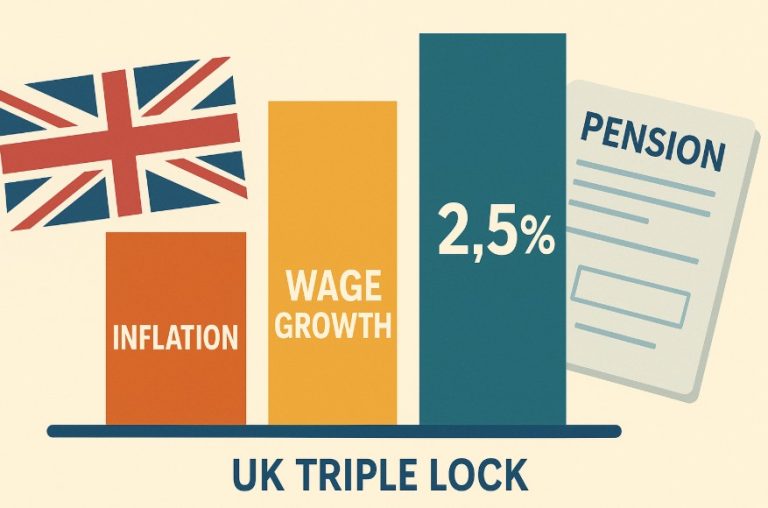The UK’s state pension has come under increasing scrutiny as comparisons with other G7 nations reveal a significant gap in retirement support.
While British pensioners receive a modest portion of their pre-retirement income from the state, countries like Italy and France offer far more generous systems.
This blog explores how the UK measures up against its global peers, the structural reasons behind the disparity, and what it could mean for the future of retirement in Britain.
How Does the UK’s State Pension Compare to Other G7 Countries?

Recent data highlights that the UK’s state pension provides one of the lowest returns among G7 nations. On average, UK pensioners receive just 22% of their pre-retirement income from the state pension, as reported by Fidelity International. In contrast, Italy offers a replacement rate of 76%, while France provides approximately 58%.
This significant disparity indicates that UK retirees depend heavily on private or occupational pensions, while in countries like Italy and France, the state pension often forms the main source of retirement income.
State Pension Replacement Rates Across G7
| Country | Replacement Rate (%) | Average Annual State Pension (£) |
| UK | 22 | 11,502.40 |
| France | 58 | ~19,500 |
| Italy | 76 | ~22,300 |
| Germany | 52 | ~17,800 |
| Canada | 45 | ~16,000 |
| Japan | 40 | ~15,500 |
| USA | 49 | ~18,200 |
The UK’s position at the bottom of the list indicates systemic limitations in how the state pension is structured and funded. This becomes even more noticeable when comparing what other G7 nations provide through their social security systems.
Why Is a Direct Comparison of State Pensions Across the G7 Difficult?
While numerical comparisons are helpful, understanding the complexity behind each pension system is crucial. Each G7 country uses different models to determine eligibility, payment amounts, and retirement ages.
For instance, the UK’s state pension is tied directly to National Insurance contributions. To qualify for the full amount, a person must have 35 years of contributions.
In contrast, Italy’s social security system functions as a comprehensive safety net, funded by higher payroll taxes. Italian employees contribute between 9% and 11% of their salary, not just for pensions but for other welfare benefits as well. This larger pool of funding allows Italy to provide higher pension replacement rates.
France calculates state pensions based on an average of the 25 highest-earning years of an individual’s career. The amount received is generally 50% of that average, with specific minimum and maximum caps.
This model benefits those with consistent, high-earning careers and offers a more earnings-reflective outcome than the UK’s flat-rate system.
What Role Does the State Pension Play in the UK’s Retirement System?

In the UK, the state pension is often viewed as a foundational income stream, not a full retirement solution. It is assumed that individuals will supplement it through:
- Auto-enrolment workplace pensions
- Private personal pensions
- Property and other long-term investments
Auto-enrolment has been effective in increasing workplace pension participation. The opt-out structure has encouraged higher enrolment rates, especially among younger workers.
However, despite this success, recent studies suggest many are still not saving enough to achieve financial security in retirement.
According to Standard Life, a significant portion of the population expects to retire later than originally planned, primarily due to financial constraints.
More than half of survey respondents reported anxiety over insufficient pension savings. This indicates a growing gap between the level of support offered by the state and the amount required for a comfortable retirement.
How Do Pension Ages and Life Expectancy Affect Retirement Income Across the G7?
Retirement age is another critical factor. In the UK, the state pension age is 66, scheduled to rise to 67 by 2028. This places it within the average range for G7 countries.
However, what varies more substantially is the number of years a person is expected to receive pension benefits based on life expectancy and retirement age.
Pension Age and Duration Comparison
| Country | State Pension Age | Life Expectancy (Post-Retirement) | Years Receiving Pension |
| UK | 66 | 85.8 | 19.8 |
| France | 64 | 90.1 | 26.1 |
| Italy | 67 | 89.8 | 22.8 |
| Canada | 65 | 87.4 | 22.4 |
| Japan | 65 | 89.7 | 24.7 |
| USA | 67 | 87.6 | 20.6 |
| Germany | 65 | 86.5 | 21.5 |
Despite having a lower pension age than some of its peers, the UK’s shorter pension duration reflects broader demographic and policy trends.
A longer lifespan paired with delayed retirement could strain public pension systems, especially if contribution levels and fund reserves are not adjusted accordingly.
How Much Do G7 Governments Spend on State Pensions?
Government spending on pensions is a strong indicator of a country’s commitment to supporting its retirees. The UK currently allocates just 4.7% of its GDP to state pensions.
This figure is tied for the lowest in the G7, matched by Canada. Italy, by contrast, devotes 12.8% of its GDP, while France exceeds even that with 13.4%.
Low government spending in the UK is partly a result of its pension design, which puts more responsibility on individuals to build their retirement through personal savings and employer schemes.
However, critics argue that this approach creates inequality, especially for those who were self-employed or earned low wages and have limited ability to contribute significantly to private pensions.
There are ongoing discussions about the sustainability of the UK pension system. As pension payments are expected to rise significantly due to inflation and wage indexation, some financial analysts have raised concerns.
Proposals have included increasing the pension age further, potentially as high as 80 in the long term, to keep the system financially viable. Such changes would likely face political and public opposition.
What Other Services Impact Pensioners’ Financial Security in G7 Nations?
Comparisons between state pension systems must also account for other government-funded services that affect retirees. The UK’s National Health Service (NHS) is a unique benefit in the G7 context.
The NHS provides comprehensive healthcare that is free at the point of use, significantly reducing out-of-pocket medical expenses for pensioners.
In the United States, retirees often face substantial healthcare costs unless they qualify for Medicaid or can afford private insurance.
In Canada, while the system is public, there are still notable costs for prescriptions and some specialised services. European countries like Germany and France offer high-quality healthcare but with more reliance on insurance contributions or co-payments.
Therefore, while the UK may offer lower direct pension income, the value of universal healthcare should be considered part of a retiree’s total support package.
For many older adults, access to healthcare without financial stress is a crucial component of a dignified retirement.
What Are the Long-Term Implications for British Pensioners?

The combination of a low replacement rate, modest government pension spending, and growing life expectancy presents long-term challenges. If current trends continue, many British retirees may face:
- Delayed retirement due to financial necessity
- Heavier reliance on family or housing wealth
- Reduced standard of living in later years
As life expectancy increases, more retirees will need to stretch limited pension income over longer periods. Without stronger state support or significant personal savings, the risk of old-age poverty may rise.
Policymakers may need to explore reforms that improve the adequacy of pensions, increase incentives for private savings, or restructure how pensions are calculated to better reflect lifetime earnings.
How Can the UK Improve Its Pension System to Match G7 Peers?
To reduce the disparity with other G7 nations, the UK could consider policy changes that strengthen both public and private pension systems. Some areas of potential reform include:
- Increasing the base state pension to improve the replacement rate, especially for low-income earners
- Revising the flat-rate calculation to a model that reflects income over a person’s working life
- Offering additional state-funded top-ups or credits for those unable to contribute sufficiently
- Expanding auto-enrolment policies to include more part-time and low-income workers
- Promoting financial education to encourage early and consistent retirement saving
These adjustments could help narrow the gap between the UK and its international peers while providing a more secure and sustainable future for British pensioners.
Conclusion
The evidence is clear: Britain’s state pension lags behind its G7 counterparts in both replacement rate and government investment. While indirect support systems like the NHS help to ease some financial burdens, they don’t replace the need for a robust, dependable pension system.
With future pension costs rising and life expectancy extending, it’s time for the UK to reconsider how it values and supports its ageing population. A balanced, transparent, and adequately funded retirement system is not just a policy goal—it’s a social necessity.
Frequently Asked Questions
What is the replacement rate in the UK’s state pension?
The UK’s replacement rate is 22%, meaning retirees receive about 22% of their pre-retirement income from the state pension.
Why is Italy’s state pension so much higher than the UK’s?
Italy mandates higher employee contributions (9–11% of salary) to its social security system, which funds a more generous public pension.
How is the UK state pension funded compared to other G7 countries?
It’s primarily funded through National Insurance contributions, unlike countries like Italy or France that use broader social security levies.
Are UK pensioners more reliant on private savings than G7 peers?
Yes. Due to the low state pension, UK retirees depend more on workplace and private pensions to supplement their retirement income.
What is the current state pension age in the UK vs other G7 nations?
The UK’s state pension age is currently 66, increasing to 67. Other G7 countries vary, with retirement ages between 64 and 67.
How does government spending on pensions vary across G7 countries?
The UK spends 4.7% of its GDP on pensions, the lowest among G7 countries. Italy spends the most at 12.8%.
Is the UK planning any reforms to improve its state pension?
There are discussions about raising the pension age and enhancing auto-enrolment, but no major reforms have yet been enacted.






